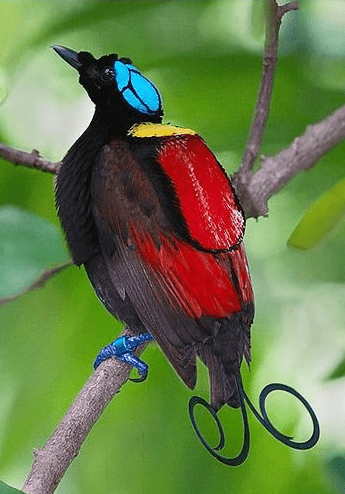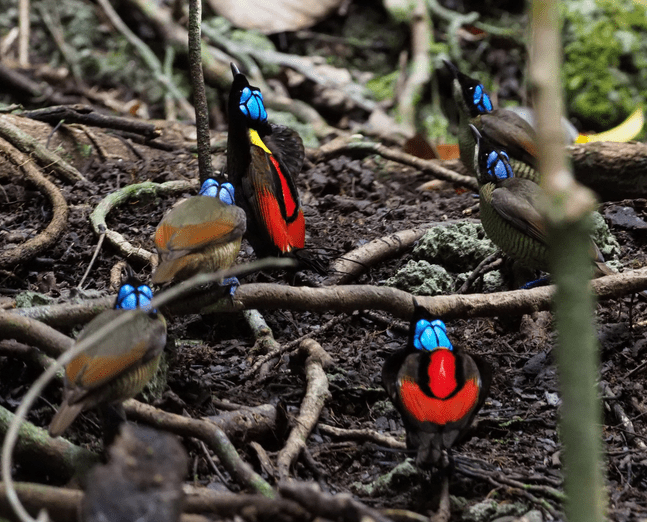Behold to the magnificent Wilson’s bird-of-paradise! With its flamboyant plumage and elaborate mating ritual, this bird is a true spectacle of nature. However, behind its striking appearance lies a story of struggle and survival. Let’s have a look at the most intriguing Wilson’s Bird-of-paradise facts below!
Phylum: Chordata
Class: Aves
Order: Passeriformes
Family: Paradisaeidae
Genus: Cicinnurus
1. They are gorgeous birds
The Wilson’s bird of paradise is a bird-of-paradise species that belong to the family Paradisaeidae. Because of their striking vibrant look and distinctive blue crown resembling a cap, the males of these birds are easily distinguished from other species.
They showcase a striking blend of colors, with brownish-black upper wings, a crimson back and wing tips, a green breast, violet legs and feet, a yellow cape, and a tail adorned with violet-blue feathers that divide into two curlicues. Altogether, it creates a beautiful bird to behold.

One of the most special features of these male birds is their vibrant blue naked head with a criss-cross pattern made of black feathers. The brightness of their head is so prominent that you can see it visible even in low light conditions while they are flying.
Wilson’s bird-of-paradise exhibits a remarkable degree of sexual dimorphism. While the males are so colorful, the females have a drab reddish-brown body and a light blue head. And they lack the curly tail like their male counterparts.
On average, these birds measure around 6.3 inches (16 cm) in length, while males can grow up to 8.25 inches (21 cm) long including their tail.
2. There’s a story about their name
In the 1800s, it was common practice for zoologists to pay tribute to members of the royal family by naming newly identified species after them, like the King-of-saxony bird-of-paradise. However, the Wilson’s bird is an exception.
This avian species was first documented by Charles Lucien Bonaparte, the nephew of the renowned Napoleon Bonaparte. However, unlike his contemporaries, Charles was a committed Republican. That’s why he brought the word “republica” into the bird’s scientific name – Cicinnurus respublica.

How about its common name – Wilson’s bird-of-paradise? The reason behind it is that Charles Bonaparte obtained the specimen from a British ornithologist named Edward Wilson. To pay tribute to Wilson, the bird was named after him.
In Malay, this bird is referred to as “the bird of the gods,” pronounced as “manuq dewata.” In Indonesian culture, Wilson’s bird-of-paradise is a symbol of wealth, sexual attraction, and dominance over one’s surroundings.
3. They live on islands
The exclusive habitat of Wilson’s bird-of-paradise is restricted to the islands of Batanta and Waigeo, situated along the northern coastline of West Papua, a province in eastern Indonesia.

The topography of these 2 islands comprises wooded areas, rolling hills, and open woodlands. The Wilson’s birds favor the mossy woods and the dense rainforests nestled in the mountainous terrain. They can also be spotted in lowland rainforests, however, it is not their typical habitat.
They like to live in an altitude range that falls between 984 to 3,937 feet (300 to 1,200 meters). This is why you can barely see them.
4. They are still a mystery
Wilson’s bird-of-paradise lives a lonely life, they just gather together twice a year in the mating season. The rest of them seldom encounter each other in their natural habitat.
Due to its enigmatic nature, the Wilson’s birds are the least studied species among the bird-of-paradise species. It’s very challenging to know their other behavior, or whether they are hostile or not.
Although not a vocal bird, you can still hear their voice in the forest. It sounds like a car alarm, but that shrill.
5. Diet
The Wilson’s bird is omnivorous, feeding both plants and animals. This helps them get a good mix of protein and carbohydrates from their meals. They can eat fruits, arthropods, and insects.
These birds are preyed upon by owls, hawks, snakes, and even humans.

6. The male dance to woo the female
The Wilson’s bird-of-paradise has 2 mating seasons in a year. The first one takes place between May and June, while the second one occurs in October during the fall season.
To attract potential mates, the male bird has developed elaborate and eye-catching tail feathers. When wiggling the tail, it will flash a blueish-white in the light. The tail will partly decide whether the female wants to mate with the male or not. The curlier tail feathers, the more mating chance the male gets.
In addition to their flamboyant tail feathers, the male Wilson’s bird-of-paradise engages in a unique display that involves calling and dancing. This mating dance is also applied by other male bird-of-paradise species.
To prepare for the show, the male carefully selects a small area of ground beneath the thick canopy where there’s less sunlight to make sure he is the only colorful object. He will meticulously remove leaves, twigs, and other debris until the ground is stripped of any forest cover, leaving only some bare branches surrounding.
Once the stage is ready, he positions himself nearby and begins calling out to attract a female’s attention. When an intrigued female arrives, she will perch above the male and observe him closely. The male will then flaunt his green throat feathers from below and open his beak to reveal the dazzling hues inside.

By staying below the female, the male Wilson’s bird of paradise is able to capture and reflect the maximum amount of light, showcasing his vibrant colors.
During the courtship display, he will also reveal his light green wide disc-like throat feathers. According to scientists, this is the characteristic that most attracts females during the mating ritual.
The male Wilson’s bird-of-paradise is polygynous, he can mate with different at the same time. After mating, the male returns to the mating dance area to woo another female. On the other hand, the female will go to construct a nest in the junction of a tree, utilizing materials like vines, ferns, and leaves.

She devotes the majority of her time to nurturing her offspring. The male doesn’t participate in this but he instead safeguards the area that the females inhabit. The baby birds reach sexual maturity at the age of 2 – 3 years. In their natural habitat, their life span is brief, about 5 – 8 years. However, in captivity, they may live up to thirty years!
8. Threats
The Wilson’s bird-of-paradise has a very limited range, inhabiting only two small Indonesian islands. Unfortunately, habitat loss due to logging in the forests is a major threat to their survival. Because these birds heavily rely on trees for food sources, mating places, and nesting sites, they are vulnerable to extinction without rainforests.

According to the IUCN list, Wilson’s birds are classified as “Near Threatened.” Since they are difficult to spot, it is unclear how many of them are left. However, their numbers are declining as the islands become increasingly developed over time.
Given the circumstances, scientists are closely monitoring the populations and forests.
Reference:

